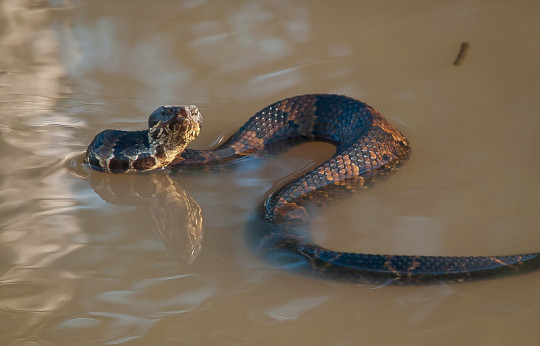#vipers
Explore tagged Tumblr posts
Text

twins
#reptiles#snakes#vipers#thanks Calvin#thanks jays#snake#reptile#reptiblr#rat snake#Texas rat snake#scaleless Texas rat snake#goth#gothic#dark#grunge#horror#dark aesthetic#cottagecore#cottagecore aesthetic#forestcore#dark academia#dark acadamia aesthetic#darknature#dark naturalism#dark and moody#photooftheday#folkscenery#dark photography#darkaesthetic#moody
2K notes
·
View notes
Text

A short-tailed mamushi (Gloydius brevicauda) preys on a Chinese red-headed centipede (Scolopendra mutilans) in Korea
by Jean-Jacques Strydom
#short tailed mamushi#vipers#snakes#reptiles#gloydius brevicauda#gloydius#viperidae#serpentes#squamata#reptilia#chordata#chinese red headed centipede#centipedes#myriapods#scolopendra mutilans#scolopendra#scolopendridae#scolopendramorpha#chilopoda#myriapoda#arthropoda#wildlife: korea#wildlife: asia#predation#animal death
204 notes
·
View notes
Text

Alright, for my last post from my trip I’m sharing this absolutely beautiful snake that I was SO lucky to spot while hiking up Santa Ana volcano. This is a Wilson’s/Honduras Montane Pitviper, I suspect a juvenile or young adult.
I love pretty much all reptiles but being able to find and photograph this snake was particularly rewarding for several reasons. For one, this species is only found in a small range in Central America, meaning it’s not a snake I’ll have opportunity to see elsewhere. Many reptile enthusiasts will go their entire lives without getting to see this species of snake! This was also an interesting find because this snake was hiding about 2 feet off of an extremely popular hiking trail. Probably about a hundred people unknowingly walked past this snake’s hiding place and were none the wiser. My guide only spotted it because I mentioned I was interested in reptiles and insects as well as birds so he was looking closely. Staggering and a little scary to think of how many people walked within arm’s reach of this animal that could kill them! It’s a good reminder that snakes never go out of their way to hurt us humans; all they really want to do is mind their own business.
We of course let the rangers know about a venomous snake so close to the trail so other tourists could be directed out of harms way until the snake moved along. I know most people would NOT be happy to see a pit viper on their hike but I come from a place with quite a few venomous snake species and as a result I admire and respect them in the same way I would any other dangerous wild animal, like a bear or crocodile. Just because they have the capacity to cause us grave harm, doesn’t mean they don’t deserve their place here on Earth. Getting to photograph this beautiful snake AND eating an orange popsicle at the top of a volcano made for a damn fine day


120 notes
·
View notes
Text

Natural History in Zoological Gardens, by Frank E. Beddard. Illustration by Winifred Austen. 1905.
Internet Archive
209 notes
·
View notes
Text



Managing the Mangshan Viper
The mangshan viper, also known as the Mang Mountain pit viper, the Chinese pit viper, and the iron-headed pit viper (Protobothrops mangshanensis), is a species of pit viper found in south-central China. It is endemic to the Mangshan mountain region and the surrounding areas, and is typically found in tropical montane forests at elevations of 800–1,300 m (2,600–4,300 ft).
Mangshan pit vipers are notoriously hard to spot due to their camouflage-patterned green and brown scales, which are perfectly suited to blend into the forest. However, they grow to be quite large; some up to 203 cm (6.66 ft) and weighing 5 kg (10 lbs). In fact, they are among the largest members of the pit viper family.
P. mangshanensis is a notoriously shy and solitary species. They are nocturnal, using their camouflage to remain hidden and their 'pit organs' to sense the heat of passing prey. They feed primarily on rodents, birds, and frogs. Thanks to their size, ability to blend in, and their incredibly potent venom, adults have virtually no predators. Eggs and juveniles however, may be vulnerable to birds of prey, larger reptiles, and carnivorous mammals.
Though the start of the breeding season is unknown, females lay eggs in June or July. They may lay up to 27 eggs in a clutch, in a nest built from leaf litter, and guard them until they hatch some 50 days later. This is unusual among pit vipers, as most other species are oviviparous- incubating the eggs internally and giving birth to live young. Once the eggs hatch, the young are fully independent. Individuals may live up to 25 years in the wild.
Conservation status: The Chinese pit viper is classified as Endangered by the IUCN. There are approximately 500 individuals in the wild, and the population is believed to be declining due to illegal hunting and collection for the pet trade, habitat destruction, and climate change. There are about 150 Mangshan pit vipers in zoos and husbandry programs.
Photos
Los Angeles Zoo
Julie Larson
Václav Šilha
#mangshan pit viper#Squamata#Viperidae#pit vipers#vipers#snakes#serpents#squamates#reptiles#tropical forests#tropical forest reptiles#mountains#mountain reptiles#asia#east asia
100 notes
·
View notes
Text

All Hail Chaos, two beautiful sociopaths 🐍🐍🐍🐍🐍🐍
#art#awesome#artists on tumblr#fanart#lgbtq#gay artist#book#lgbt#bookaholic#all hail chaos#sarah rees brennan#long live evil#rae parilla#key of the cauldron#key#epic fantasy#bookfanatic#book fandom#book fanart#book recommendations#romantasy#fantasy#romance#fantasy books#viper#vipers#long live evil fanart#🐍
62 notes
·
View notes
Text

33 notes
·
View notes
Text


hello followers... heres another snake
wagler's pit viper (Tropidolaemus wagleri) with its beautiful unidirectional scales... this one is an adult female due to the colours of its scales
these vipers are nocturnal so i had to go deep into the forest at night to find her... theyre also known for being one of the chillest vipers, and are incredibly hesitant to attack humans even when they feel threatened
24 notes
·
View notes
Text

The Head of Medusa by Peter Paul Rubens and Frans Synders
#medusa#art#peter paul rubens#frans synders#greek mythology#gorgon#snakes#vipers#snake#viper#ancient greece#ancient greek#mythology#mythological#europe#european
111 notes
·
View notes
Text

white-lipped pit viper ink drawing
Continuation of some snake doodles with this sketch of a white-lipped pit viper!
#artwork#art#artists on tumblr#krita#animals#ink#snakes#snake#reptiles#reptile#serpent#serpents#vipers#viper#pit viper#snek#traditional art#traditional drawing#traditional illustration#illustrations#sketching#sketch#doodles#sketches
26 notes
·
View notes
Text
Evan: I think you should apologise
Regulus: I think you should die but we don’t always get what we want bitch
Barty: Don’t kill him Reg. I rather like him
Regulus: And I think you should die too but you know, murder is illegal, blah blah blah
Evan:
Barty:
Regulus:
Regulus: Still won’t stop me though
#marauders era#dead gay wizards#regulus black#evan rosier#barty crouch jr#rosekiller#slytherin skittles#slytherin#vipers#marauders incorrect quotes
204 notes
·
View notes
Text

A northern cottonmouth (Agkistrodon piscivorus) in Arkansas, USA
by Alan
#cottonmouth#northern cottonmouth#vipers#snakes#reptiles#agkistrodon piscivorus#agkistrodon#viperidae#serpentes#squamata#reptilia#chordata#wildlife: arkansas#wildlife: usa#wildlife: north america
220 notes
·
View notes
Text

Side-striped Palm Pit Viper Bothriechis lateralis
7/25/2023 Monteverde Cloud Forest, Costa Rica
#side striped palm pit viper#pit viper#viper#vipers#snake#snakes#reptile#reptiles#reptiblr#costa rica#monteverde#cloud forest#rainforest#puntarenas#central america#bird#birds#bird photography#wildlife#nature#nature photography#wildlife photography#birding#birdwatching#my photos
30 notes
·
View notes
Text

Asp (Vipera aspis)
Reptiles and Amphibians of the World. Written by Hans Hvass. Illustrated by Wilhelm Eigener. Originally published in 1958.
Internet Archive
173 notes
·
View notes
